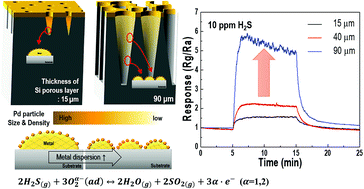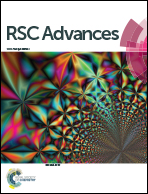Ultrasensitive detection of low-ppm H2S gases based on palladium-doped porous silicon sensors†
Abstract
In this study, the sensing properties of palladium-doped porous silicon (Pd/p-Si) substrates for low-ppm level detection of toxic H2S gas are investigated. A Si substrate with dead-end pores ranging from nano- to macroscale was generated by a combined process of metal-assisted chemical etching (MacE) and electrochemical etching with tuned reaction time, in which nano-Pd catalysts were decorated by E-beam sputtering deposition. The sensing properties of the Pd/p-Si were enhanced as the thickness of the substrate layer increased; along with the resulting variation in surface area, this resulted in superior H2S sensing performances in the low-ppm range (less than 3 ppm), with a detection limit of 300 ppb (sensitivity 30%) at room temperature. Furthermore, the sensor displayed excellent selectivity toward the hazardous H2S molecules in comparison with various other reducing gases, including NO2, CO2, NH3, and H2, showing its potential for application in workplaces or environments affected by other toxic gases. The enhancement in sensing performance was possibly due to the increased dispersion and surface area of Pd nano-catalysts, which led to an increase in chemisorption sites of adsorbate molecules.



 Please wait while we load your content...
Please wait while we load your content...